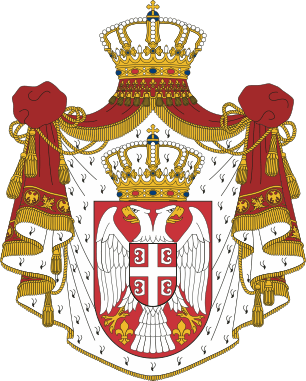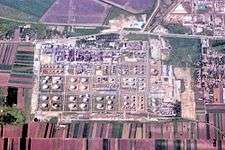Energy in Serbia
| Economy of Serbia |
|---|
 |
| Overview |
| Sectors |
| Serbia topics |
|
Energy in Serbia describes energy and electricity production, consumption and import in Serbia.
Electricity
The main producer of electricity in Serbia is Elektroprivreda Srbije. The company has an installed capacity of 7,662 MW and generates 38.9 TWh of electricity per year. Its installed capacity in lignite-fired thermal power plant is 4,390 MW, gas-fired and liquid fuel-fired combined heat and power plants is 336 MW, and hydro power plants is 2,936 MW.[1] EPS is also the largest producer of lignite in Serbia operating in the Kolubara and Kostolac basins, producing around 37 million tonnes per year.[2] Also, 20 MW is generated from wind power, mainly through facilities of MK Fintel Wind.
In order to increase the efficiency of the sector through the action of market mechanisms in the production and supply of electricity, the Serbian government has been introduced competition in the electricity sector by adopting the Law on Energy in 2004. All electricity consumers are tariff buyers which are, according to the law, provided by electricity retailer responsible to supply tariff customers within Elektroprivreda Srbije at regulated prices. At the same time buyers who meet the criteria according to the Act is given the opportunity to become a qualified buyer, and thus get the opportunity to purchase electricity on the open market. In the first phase, the electricity market has been open to all potential customers with an annual electricity consumption was above 25 GWh. From 1 January 2007, the Council of the Energy Agency of the Republic of Serbia made decision that the right to acquire the status of an eligible customer is available to all electricity customers with an annual consumption of more than 3 GWh.
Oil and Natural Gas

Naftna Industrija Srbije is the only company in Serbia which deals with exploration and production of crude oil and gas, as well as with production of geothermal energy.[3] The company disposes with all necessary equipment for the performance of a whole range of complex activities such as geophysical exploration, control of production of crude oil, gas and geothermal energy. The majority of NIS oil fields are located on the territory of Serbia, in Banat region, but upstream has business operations both in Serbia and abroad. In 2011 NIS started to expand business in south-east Europe: in Bosnia and Herzegovina, Romania and Hungary.[4][5][6]
The company owns and operates oil refineries in Pančevo (annual capacity 4.8 million tons of crude oil) and Novi Sad (annual capacity 2.6 million tons of crude oil), and natural gas refinery in Elemir. NIS refining complex produces a whole range of petroleum products - from motor gasoline and diesel fuel to mechanical lube oils and feedstock for the petrochemical industry, heavy fuel oil, road and industrial bitumen, etc.
Srbijagas, public gas company, operates the natural gas transportation system which comprise 3,177 kilometers of trunk and regional natural gas pipelines and a 450 million cubic meter underground gas storage facility at Banatski Dvor.[7]
Refined petroleum products - production: 60,220 barrels per day (9,574 m3/d)
Oil - production: 23,160 barrels per day (3,682 m3/d)
Oil - consumption: 81,540 barrels per day (12,964 m3/d) (2011)
Oil - proved reserves: 77.5 million barrels (12.32×106 m3) (1 January 2006)
Natural gas - production: 557 million cubic metres (2012)
Natural gas - consumption: 2.84 billion cubic metres (2012) [8]
Renewable energy
Installed capacity of hydro power is 2,835 MW and wind power is 20 MW (in the process of being expanded to produce a total of 320 MW).[9] Serbia also makes use of geothermal and solar energy, currently 27% of Serbia's electricity comes from hydro while 4% comes from other renewables.[10]
See also
References
- ↑ "Производни капацитети". eps.rs (in Serbian). Retrieved 15 January 2018.
- ↑ "EPS". Energy Fundamentals. Archived from the original on 6 November 2013. Retrieved 15 June 2013.
- ↑ "Cooperation of Vojvodina and NIS in the field of geothermal energy".
- ↑ "Serbia's NIS to expand in four E. European states". Reuters. 2 September 2011.
- ↑ "NIS plans to invest into Romania several hundred million euros".
- ↑ "NIS and RAGF signed an Agreement on Exploration in Hungary".
- ↑ http://www.srbijagas.com/o-preduzecu/delatnost/transport/transport-prirodnog-gasa.67.html
- ↑
- ↑ "Electric Power Industry of Serbia 2004" (PDF). RENEUER. Archived from the original (PDF) on 5 November 2010. Retrieved 15 June 2013.
- ↑
